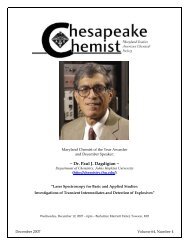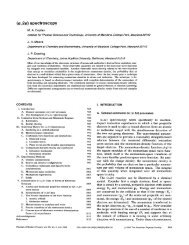Graduate Study in - Chemistry - Johns Hopkins University
Graduate Study in - Chemistry - Johns Hopkins University
Graduate Study in - Chemistry - Johns Hopkins University
Create successful ePaper yourself
Turn your PDF publications into a flip-book with our unique Google optimized e-Paper software.
Gerald J. Meyer<br />
Inorganic Materials <strong>Chemistry</strong><br />
Environmental <strong>Chemistry</strong><br />
meyer@jhu.edu<br />
(a)<br />
Ph.D., <strong>University</strong> of<br />
Wiscons<strong>in</strong> at Madison<br />
Postdoctoral, <strong>University</strong><br />
of North Carol<strong>in</strong>a at<br />
Chapel Hill<br />
The Meyer group research focuses on <strong>in</strong>organic chemistry with a particular<br />
emphasis on the <strong>in</strong>terface between molecules and solid-state materials. A<br />
theme of our research has been to design materials at the molecular level that<br />
have desired optical, electrical, environmental, biological, magnetic, and/or<br />
catalytic functions. Summarized below are three key research areas:<br />
We prepare solar cells, based on<br />
Nanocrystall<strong>in</strong>e Semiconductor Interfaces.<br />
nanocrystall<strong>in</strong>e semiconductors sensitized to light with <strong>in</strong>organic coord<strong>in</strong>ation<br />
compounds that efficiently convert sunlight <strong>in</strong>to electrical power. These materials<br />
also allow <strong>in</strong>terfacial electron transfer processes to be quantified <strong>in</strong> unprecedented<br />
molecular detail. Shown below, is a schematic representation of an <strong>in</strong>terface designed<br />
for fundamental photo-<strong>in</strong>duced electron transfer studies. Other ongo<strong>in</strong>g research<br />
projects with these <strong>in</strong>terfaces <strong>in</strong>clude the study of bimetallic compounds, charge<br />
transport, energy transfer, and catalysis.<br />
Magnetic Nanowire Interfaces. Nanowires with segments of different magnetic and<br />
non-magnetic materials are prepared <strong>in</strong> our labs. An example is shown below where<br />
a magnetic nickel segment has been functionalized with a fluorescent dye while a<br />
non-magnetic gold segment has not. In the visible image (a) the two wire segments<br />
appear similar while the fluorescent image (b) clearly reveals the nickel segment. The<br />
magnetic properties of the nanowire materials are under active study as part of the<br />
Hopk<strong>in</strong>s’ NSF-funded MRSEC and can be used for applications <strong>in</strong> separations, sens<strong>in</strong>g,<br />
magnetic record<strong>in</strong>g and biotechnology.<br />
Environmental Interfaces. We prepare materials that convert sunlight <strong>in</strong>to electrical<br />
power and materials that can decontam<strong>in</strong>ate water of halocarbon pollutants. This<br />
latter project is the subject of a NSF-funded ‘CRAEMS’ program that <strong>in</strong>volves<br />
<strong>in</strong>terdiscipl<strong>in</strong>ary research with five Hopk<strong>in</strong>s groups. Our approach has been to study<br />
mechanistic aspects of organohalide reaction with natural and synthetic iron<br />
porphyr<strong>in</strong>s. These studies provide <strong>in</strong>sights <strong>in</strong>to how liv<strong>in</strong>g organisms can both<br />
dehalogenate organic halocarbons and die from exposure to them.<br />
Recent Publications:<br />
Pseudo-halogens for Dye-Sensitized TiO 2 Photoelectrochemical Cells. Oskam, G.; Bergeron, B.V; Meyer, G.J.; Searson,<br />
P.C. J. Phys. Chem. B 2001, 105, 6867.<br />
Long Distance Electron Transfer Across Molecular-Nanocrystall<strong>in</strong>e Semiconductor Interfaces. Galopp<strong>in</strong>i, E.; Guo, W.;<br />
Qu, P.; Meyer, G.J. J. Am. Chem. Soc. 2001, 123, 4342.<br />
Magnetic Alignment of Fluorescent Nanowires. Tanase, M.; Bauer, L.A.; Hultgren, A.; Silevitch, D.M.; Sun, L.; Reich, D.H.;<br />
Searson, P.C.; Meyer, G.J. NanoLett. 2001, 1, 155.<br />
Proton Controlled Electron Injection from Molecular Excited States to the Empty States <strong>in</strong> Nanocrystall<strong>in</strong>e TiO 2 .<br />
Qu, P.; Meyer, G.J. Langmuir 2001, 17, 6720.<br />
(b)<br />
Crowded Cu(I) Complexes Involv<strong>in</strong>g Benzohqu<strong>in</strong>ol<strong>in</strong>e: π-Stack<strong>in</strong>g Effects and Long Lived Excited States. Riesgo,<br />
E.C.; Hu, Y.-Z.; Bouvier, F.; Thummel, R.P.; Scaltrito, D.V.; Meyer, G.J. Inorg. Chem. 2001, 40, 3413-3422.<br />
16<br />
<strong>Graduate</strong> <strong>Study</strong> <strong>in</strong><br />
<strong>Chemistry</strong> at The <strong>Johns</strong> Hopk<strong>in</strong>s <strong>University</strong>







